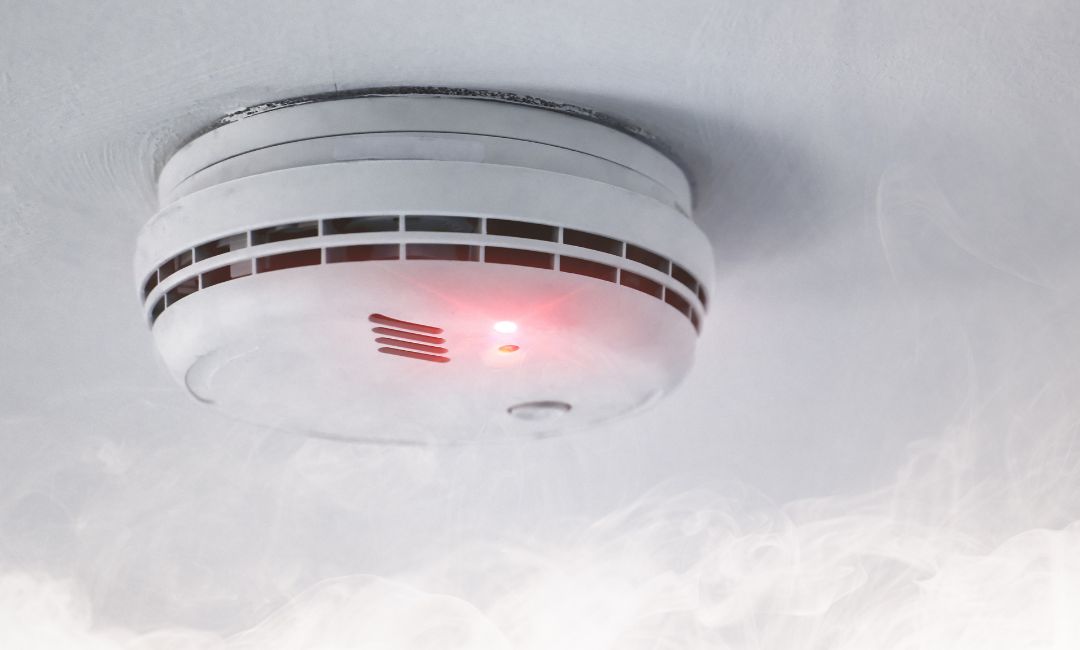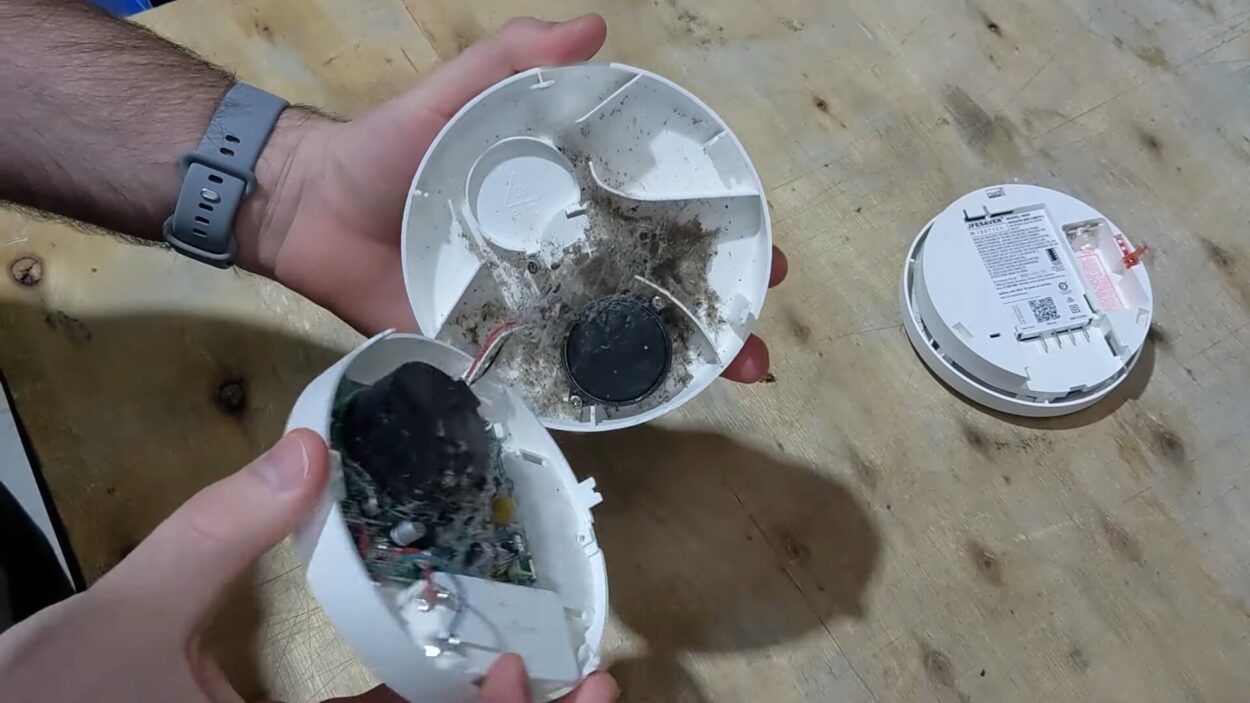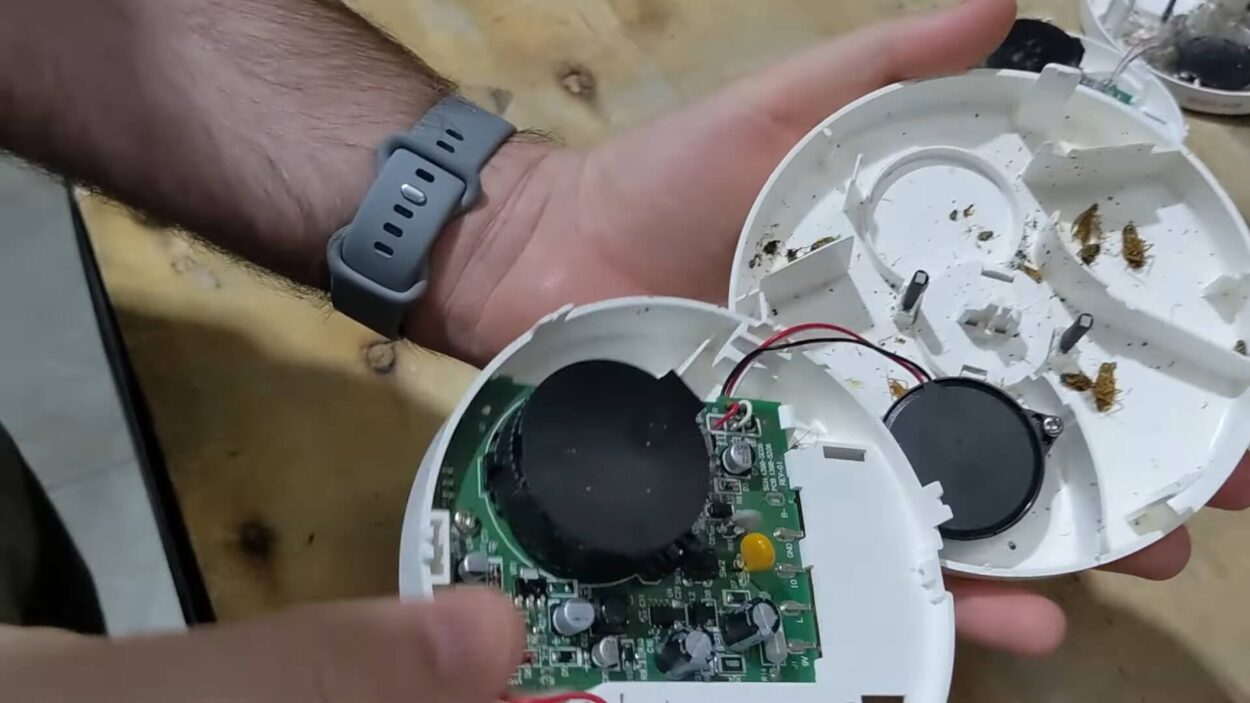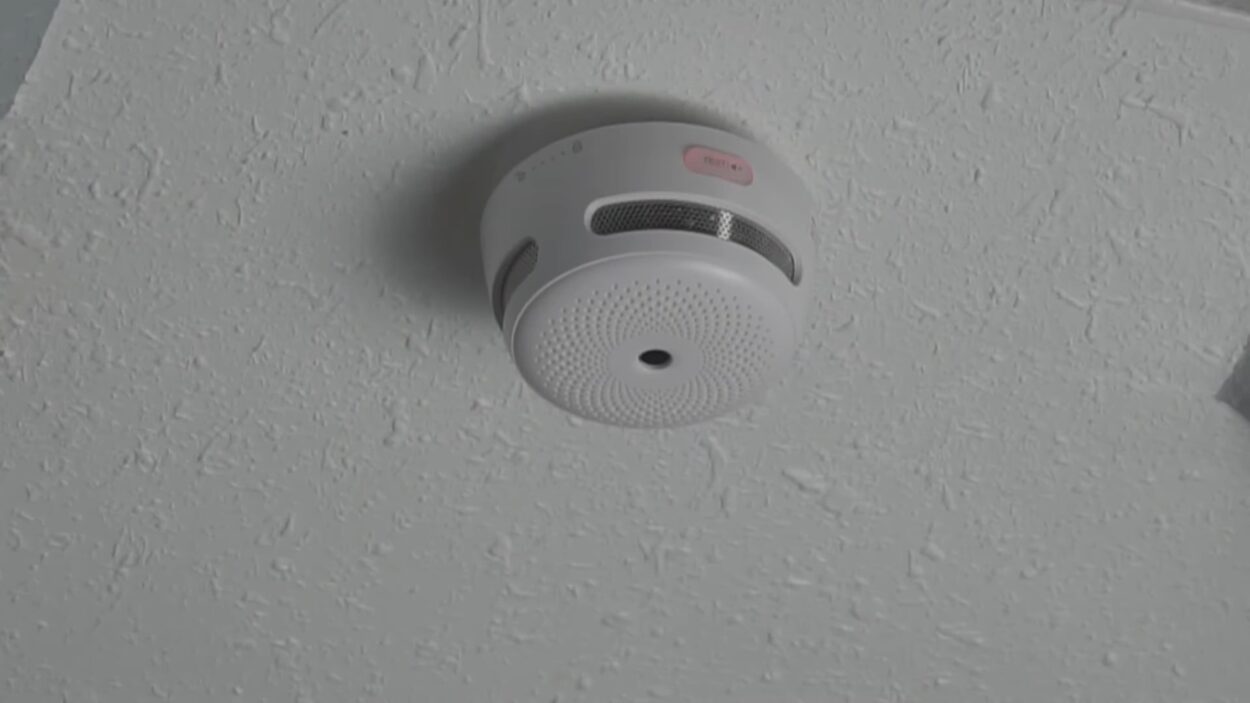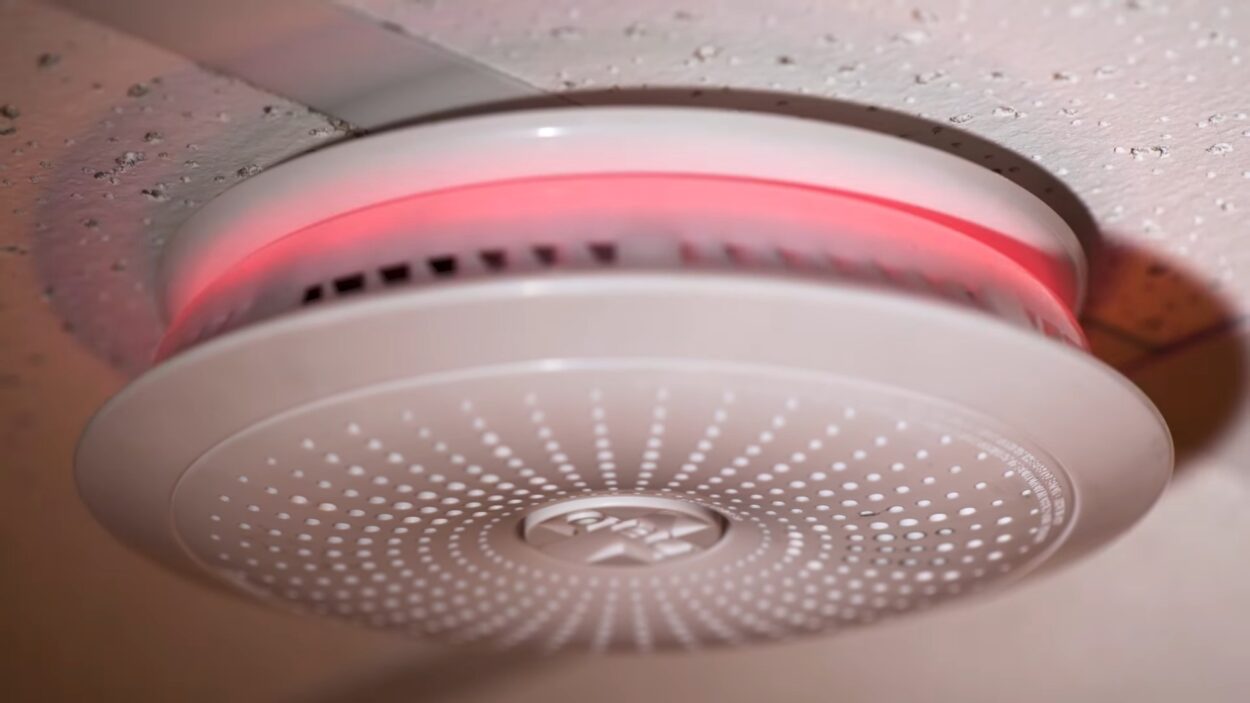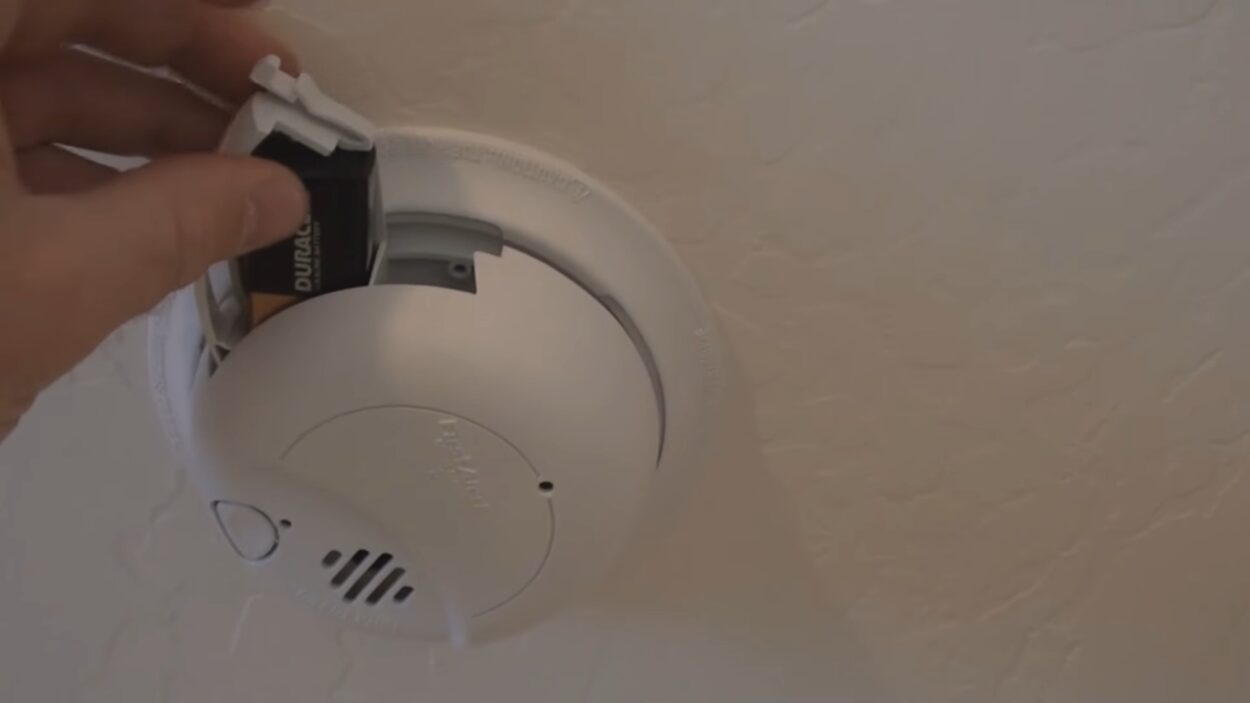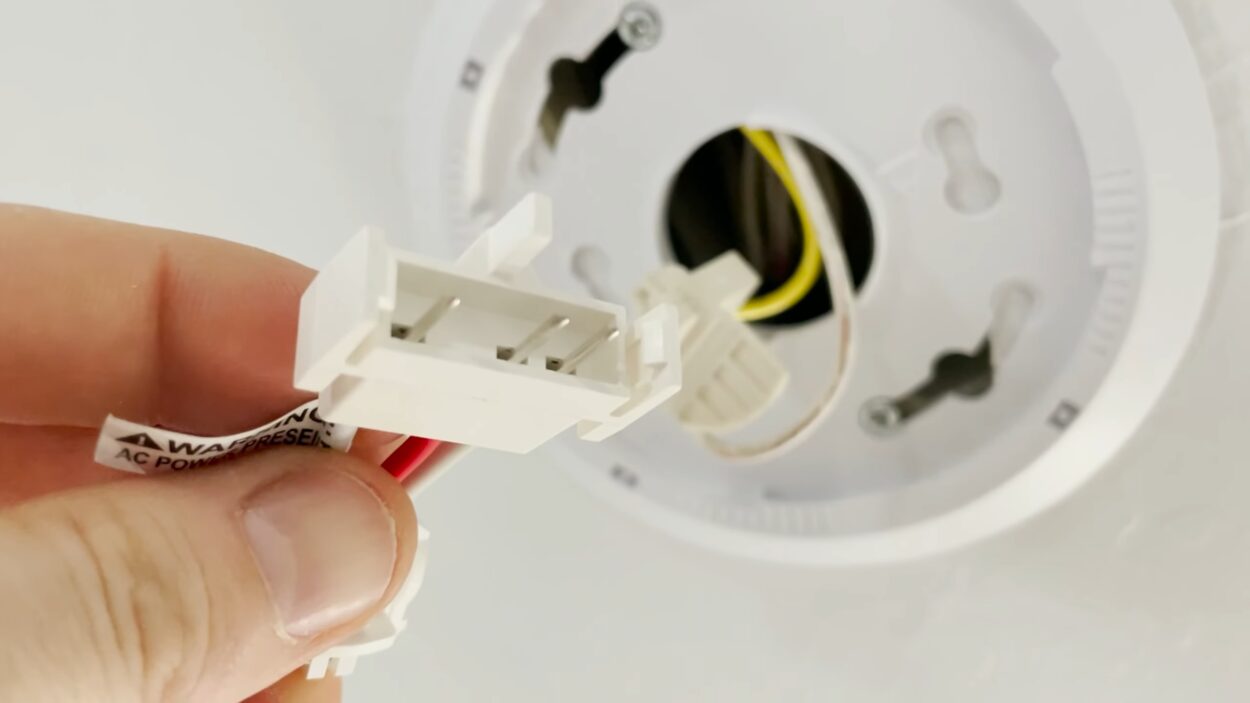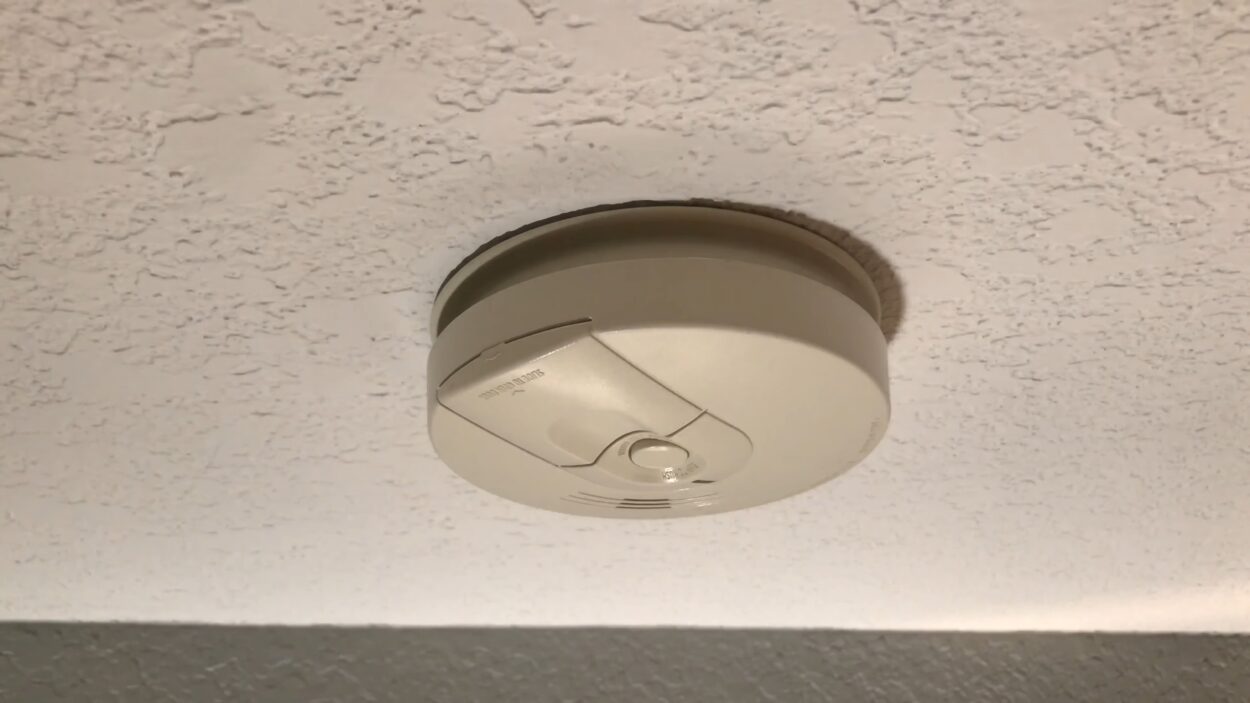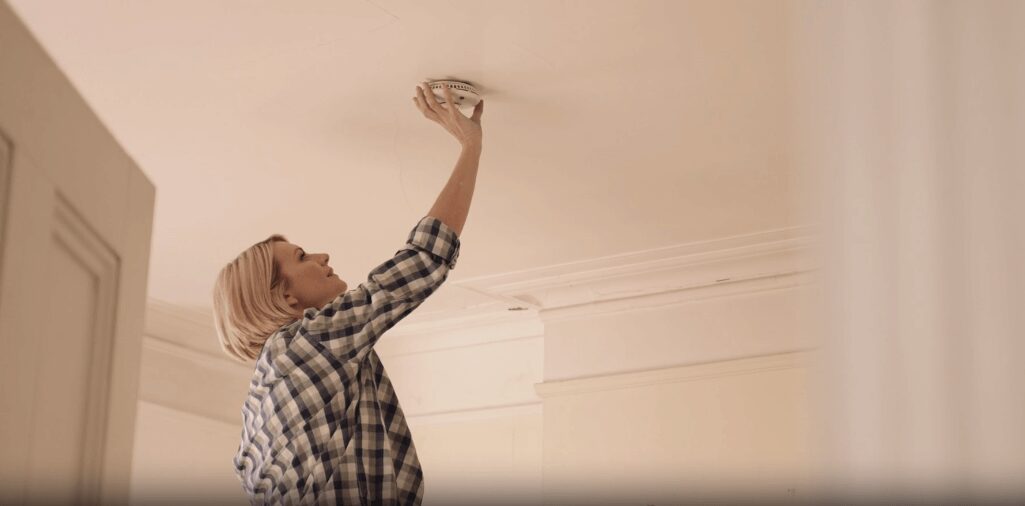Smoke alarms are a critical component in maintaining safety and preventing fire-related casualties in residential and commercial spaces. They are designed to detect smoke and alert occupants of potential fire, providing crucial time to evacuate or address the issue.
However, smoke alarms can sometimes go off without the presence of smoke, causing confusion and concern. This article delves into seven common reasons why smoke alarms may activate without smoke and offers insights into maintenance, prevention, and safety practices.
Quick Look
Smoke alarms are vital for safety, designed to alert occupants to potential fires. However, they can sometimes trigger false alarms for various reasons, necessitating understanding and preventative maintenance. Here’s a quick look at the common reasons and solutions:
| Reasons | Description |
|---|---|
| Sensitivity to Dust and Insects | Dust and insects can accumulate and interfere with the sensors, leading to false alarms. Regular cleaning and inspections are essential. |
| Humidity and Steam | High humidity and steam, especially near bathrooms and kitchens, can cause false alarms. Placement away from these areas helps. |
| Chemical Fumes and Aerosols | Household aerosols and cleaning agents can trigger alarms by releasing particles or fumes. Good ventilation and regular cleaning help. |
| Low Battery or Electrical Issues | Low battery power or faulty electrical connections can cause chirping or false alarms. Regular replacement and testing are key. |
| Interconnected Alarms | Interconnected systems ensure widespread alert but also mean one false alarm triggers all. Consistent maintenance and placement help. |
| Temperature Fluctuations | Rapid temperature changes can affect alarm sensitivity. Avoid placing alarms in areas prone to sudden changes. |
| Age and Wear of the Alarm | Alarms degrade over time, becoming less reliable. Replace smoke alarms every 10 years or as recommended by the manufacturer. |
7. Sensitivity to Dust and Insects
One of the most common reasons for smoke alarms going off without smoke is the accumulation of dust or the intrusion of small insects. Over time, dust particles can accumulate on the sensors, leading to false alarms. Insects crawling into the device can also interfere with the sensors, causing the alarm to trigger.
Regular cleaning and maintenance of smoke alarms are crucial to prevent such occurrences. This includes gently using a vacuum cleaner or a soft brush to clean the exterior and the sensor chamber, ensuring the device remains free from dust and insects.
The Intrusion of Dust
Dust comprises a variety of particles, including fabric fibers, human and pet dander, and microscopic debris. In a typical household, dust is ubiquitous and gradually accumulates over time. As it settles, it can interfere with the smoke alarm’s internal sensors.
Particularly in the case of ionization smoke detectors, dust can disrupt the electric current flow within the device, mimicking the disruption caused by smoke particles. This leads to the alarm sounding off without the presence of smoke.
To mitigate this, it’s crucial to incorporate regular cleaning into the maintenance routine of your smoke alarms. Use a vacuum cleaner with a soft brush attachment to gently remove dust from the exterior casing and vents of the alarm.
It’s also advisable to open the casing if possible and feasible, following the manufacturer’s instructions, to clean inside carefully. However, caution is necessary to avoid damaging the sensitive components within the alarm.
The Issue with Insects
Insects, particularly small spiders or ants, can find their way into smoke alarms, attracted by the shelter or even the small LED lights in some models. Once inside, they can crawl over sensors, causing interruptions similar to smoke particles. In some instances, insects can build nests or leave debris inside the device, further complicating the problem.
Preventing insects from entering the smoke alarm can be challenging but not impossible. Some preventive measures include using insect repellents in the area (ensuring they don’t enter the alarm itself), sealing any large gaps or openings in the device with appropriate materials, and regular inspections, especially during warmer months when insect activity is higher.
Maintenance Tips for Homeowners
To effectively prevent false alarms due to dust and insects, homeowners should adopt a comprehensive maintenance routine:
- Regular Cleaning: At least once every six months, smoke alarms should be vacuumed and wiped down. If specific cleaning instructions are provided by the manufacturer, they should be followed precisely to avoid damaging the device.
- Inspection: When cleaning, take a moment to inspect the interior for any signs of insects or excessive dust. If the problem seems recurrent, consider more frequent cleaning or investigating if the alarm’s location is particularly prone to dust or insects.
- Test After Cleaning: Always test the smoke alarm after cleaning to ensure it’s still functioning correctly. Most units have a test button for this purpose.
- Consider Covers: In areas particularly prone to dust or insects, consider smoke alarm models that come with covers or mesh that can reduce the intrusion of these elements. Ensure that any cover used does not impede the alarm’s ability to detect smoke.
- Professional Help: If you’re unsure about cleaning the device yourself or if the alarms are hardwired and difficult to reach, consider hiring a professional to maintain them. This is also advisable for large buildings or complexes where many alarms need servicing.
By understanding the impact of dust and insects on smoke alarms and taking proactive steps to mitigate these issues, homeowners can greatly reduce the occurrence of nuisance alarms, ensuring that the smoke alarms function optimally when it matters most. This not only contributes to the safety and peace of mind but also extends the life and efficacy of the smoke alarms themselves.
6. Humidity and Steam
High humidity levels or steam can sometimes be mistaken by smoke alarms for smoke. This is particularly common in homes where the alarm is located near bathrooms or kitchens, where hot showers and cooking can produce significant steam and moisture.
When the moisture in the air reaches the sensor, it scatters light similarly to smoke particles, triggering the alarm. To mitigate this, it’s advisable to install smoke alarms away from bathrooms and kitchens or use alarms specifically designed to differentiate between steam and smoke.
The Science Behind the False Alarms
Most smoke alarms operate using either ionization or photoelectric technologies, or a combination of both. Photoelectric smoke alarms are particularly sensitive to steam and high humidity. These alarms work by using a light source that, in normal conditions, beams straight into a sensor.
When smoke enters the chamber, it scatters the light, redirecting it towards the sensor, which triggers the alarm. However, steam particles can scatter light in a similar way to smoke particles, causing the alarm to sound.
In areas like kitchens and bathrooms, where steam and high humidity are commonplace, this can be a frequent and frustrating occurrence. Cooking, boiling water, taking hot showers, or even using humidifiers can significantly increase the moisture content in the air. This moisture, when dense enough, can enter the smoke alarm and reflect light particles, leading to a false alarm.
Location, Location, Location
One of the most effective ways to prevent false alarms caused by humidity and steam is to consider the placement of smoke alarms carefully. It’s generally advisable to avoid placing smoke alarms directly in or near bathrooms, kitchens, or other high humidity areas.
Instead, they should be installed just outside of these rooms or in adjacent hallways. This placement ensures that the smoke alarm can still serve its purpose by detecting smoke coming from these areas without being directly exposed to steam and humidity.
Dealing with Humidity and Steam
Here are some strategies to minimize the impact of humidity and steam on smoke alarms:
- Proper Ventilation: Ensure that rooms with high moisture content, especially bathrooms and kitchens, are well-ventilated. Use exhaust fans, open windows, or dehumidifiers to reduce the overall humidity and steam levels in these areas.
- Use Specialized Alarms: Some smoke alarms are designed to be less sensitive to steam and humidity. For instance, photoelectric alarms are generally better for areas near bathrooms and kitchens as they are less prone to false alarms from steam compared to ionization alarms. Moreover, some models come with humidity and steam tolerance, which can significantly reduce false alarms.
- Regular Maintenance: Dust and debris can exacerbate the problem by allowing steam to cling to the sensors more readily. Regular cleaning and maintenance of the smoke alarms can prevent this issue.
- Seal the Unit: In some cases, especially in very humid climates or particular home designs, even the best-placed smoke alarm might get exposed to indirect steam or humidity. Using covers or seals that still allow smoke in but reduce steam penetration can be beneficial. These should be used with caution and always in a way that doesn’t compromise the alarm’s effectiveness.
- Relocation: If a smoke alarm consistently gives false alarms due to steam or humidity, it might be necessary to relocate it. Always refer to safety guidelines and local regulations to ensure that the new placement is safe and effective.
Alarm Types and Sensitivity
It’s also beneficial for homeowners to understand the different types of smoke alarms and their sensitivities. Ionization smoke detectors are quicker to respond to flaming fires, while photoelectric detectors are quicker at sensing smoldering fires.
Knowing which type you have can help you understand and predict its behavior concerning humidity and steam. It might be that a combination alarm or switching to a different type better suits the environment of your home.
5. Chemical Fumes and Aerosols: Navigating False Alarms
In the quest to keep homes safe and clean, we often use a variety of chemical products. However, the very smoke alarms installed to protect us can sometimes be triggered by everyday household items like aerosols and chemical fumes, leading to false alarms. Understanding how these substances interact with smoke alarms and how to prevent such occurrences is crucial for maintaining both safety and sanity.
The Culprits Behind the False Alarms
Aerosols and chemical fumes are a part of many household products, including cleaning agents, personal care products, and even some cooking sprays. These products disperse particles and chemicals into the air, which can be detected by smoke alarms.
- Aerosols: Common aerosol products like hairspray, deodorant, air fresheners, and insecticide sprays release tiny particles into the air. These particles, much like smoke, can scatter light or interfere with the ionization process in smoke detectors, leading to false alarms.
- Chemical Fumes: Strong chemical odors from cleaning agents, paint, or even heavy cooking can emit fumes that, while not visible like smoke, can be detected by sensitive smoke alarms. Some of these fumes might contain particles or be of a density that mimics smoke to the detectors.
How Smoke Alarms React to Aerosols and Chemicals
Smoke alarms detect potential fires through two main types of technology: ionization and photoelectric, each with a different sensitivity to particles and fumes.
- Ionization Smoke Alarms: These alarms are extremely sensitive to small particles in the air. They work by detecting changes in an electrical current caused by smoke, but aerosol particles can disrupt this current similarly, leading to false alarms.
- Photoelectric Smoke Alarms: These alarms are more responsive to large smoke particles produced by smoldering fires. They use a light beam that, when scattered by smoke, triggers the alarm. Aerosols and heavy fumes can scatter light in a similar manner, activating the alarm.
Strategies to Reduce False Alarms from Chemicals and Aerosols
Reducing false alarms involves understanding how and where aerosols and chemicals are used in the home and how to mitigate their impact on smoke alarms.
- Proper Ventilation: Whenever using aerosols or chemicals, ensure the room is well-ventilated. Open windows and use fans to disperse the particles and fumes. This not only reduces the risk of false alarms but also is healthier for the occupants.
- Location of Smoke Alarms: Avoid placing smoke alarms directly in bathrooms, dressing areas, or kitchens where the use of aerosols and strong cleaning agents is frequent. Instead, place them just outside these areas or in adjacent rooms.
- Regular Cleaning: Aerosols and chemical particles can build up on the sensors of smoke alarms over time, making them more susceptible to false alarms. Regularly cleaning the alarms can help maintain their accuracy.
- Use Smoke Alarm Covers: Some smoke alarms come with covers or can be fitted with them to reduce the impact of aerosols and fumes. Ensure that any cover used does not hinder the alarm’s ability to detect real fires.
- Choose the Right Type of Alarm: In areas where aerosols are used frequently, a photoelectric smoke alarm might be less prone to false alarms than an ionization type. Consider the activities in each area of your home and choose the type of alarm that best fits.
- Awareness and Education: Be aware of how everyday activities can affect smoke alarms. Educate all household members about the importance of avoiding aerosol use near smoke alarms and the need for proper ventilation when using chemicals.
4. Low Battery or Electrical Issues: Ensuring Reliable Smoke Alarm Operation
Smoke alarms are designed to be sensitive and responsive to ensure safety, but they are also prone to issues related to power supply, whether it’s from batteries or household electrical systems. Understanding how low batteries or electrical issues can affect smoke alarm functionality is crucial for maintaining ongoing safety and reliability.
The Telltale Signs of Battery Problems
The most common indicator of a low battery in a smoke alarm is a chirping sound, usually at regular intervals. This is the alarm’s way of indicating that the power is insufficient for normal operation and that the battery needs immediate replacement. It’s a deliberate feature designed to capture attention, ensuring the alarm is not left without power.
- Battery Lifespan: Different smoke alarms use different types of batteries, and each type has its expected lifespan. Regular alkaline batteries might last a year or less, while long-life lithium batteries can last several years. Knowing what type of battery your smoke alarm uses and its expected lifespan can help you anticipate replacements.
- Battery Replacement Routine: Even if the battery isn’t dead, it’s good practice to replace smoke alarm batteries annually or as recommended by the manufacturer. Some households do this during daylight saving time changes as an easy-to-remember routine.
Electrical Issues in Hardwired Systems
Hardwired smoke alarms are connected directly to the home’s electrical system, with a battery backup to ensure operation during power outages. While these systems are generally reliable, they can be affected by electrical issues that lead to false alarms or malfunctions.
- Electrical Fluctuations: Power surges, outages, and other fluctuations can affect hardwired smoke alarms. These might be caused by external factors like utility work or internal issues within the home’s electrical system. Such fluctuations can cause the alarm to chirp or go off.
- Wiring Problems: Over time, wires can degrade, become loose, or get damaged. Faulty or aged wiring not only poses a risk of false alarms but can also become a fire hazard itself. Regular inspections by a qualified electrician can ensure that the wiring remains safe and functional.
- Compatibility and Installation Issues: Sometimes, the problem lies not with the power source but with how the smoke alarm is installed or its compatibility with the home’s electrical system. Ensuring that alarms are installed according to manufacturer instructions and local building codes can prevent many of these issues.
Strategies for Managing Power-Related Issues
Dealing with low batteries and electrical issues involves a combination of routine maintenance, awareness, and sometimes professional intervention.
- Regular Testing: Test your smoke alarms monthly by pressing the test button. This simple step ensures the alarm is operational and can help identify low batteries or other issues before they become critical.
- Professional Inspection: For hardwired systems, especially in older homes or after an electrical incident, having a professional inspect the system can prevent problems. This is also an opportunity to update or replace old or malfunctioning alarms.
- Be Aware of Alarm Sounds: Different beeping patterns can indicate different things. A consistent chirp typically indicates a low battery, while an intermittent noise might suggest an electrical fault. Consult your smoke alarm’s manual to understand what different sounds mean.
- Keep Spares and Understand Instructions: Keep spare batteries on hand and ensure they are the correct type for your alarms. Understand and follow the manufacturer’s instructions for battery replacement and alarm reset procedures.
- Consider the Alarm’s Age: Smoke alarms don’t last forever. Most manufacturers recommend replacing smoke alarms every 10 years. If your alarms are old or if you don’t know their age, consider replacing them to ensure reliability.
3. Interconnected Alarms: Maximizing Safety and Minimizing False Alarms
Interconnected smoke alarms represent a significant advancement in residential and commercial safety. By linking alarms together, they create a network that ensures prompt alert of danger across an entire structure. However, while this system amplifies protection, it also amplifies the inconvenience and potential risk of widespread false alarms.
How Interconnected Alarms Work
Interconnected smoke alarms are linked so that when one alarm detects smoke or a significant rise in temperature, all connected alarms simultaneously activate. This system ensures that, no matter where in the building the occupants are, they will be alerted to danger. This is particularly beneficial in large homes or over multiple floors where an alarm in an isolated area might not be heard.
These alarms can be interconnected using wires (hardwired) or wirelessly through radio frequency signals. Hardwired systems are often installed during the building process, while wireless systems can be installed anytime and are especially beneficial for retrofitting older homes without needing extensive wiring.
The Challenge of False Alarms in Interconnected Systems
While interconnected alarms are effective in alerting the entire household to danger, they also mean that a false alarm in one detector will trigger all connected alarms. This situation can be especially disruptive and lead to alarm fatigue, where occupants may become desensitized to alarms due to frequent false activations.
Common causes of false alarms in interconnected systems include:
- Dust and Debris: As with any smoke alarm, dust and debris can interfere with the sensors of interconnected alarms, leading to false alarms.
- Steam and Humidity: A detector placed near a bathroom or kitchen might pick up steam as smoke, setting off all alarms.
- Insects and Small Animals: Insects crawling into one alarm can set off the entire system.
- Electrical Fluctuations: For hardwired systems, electrical surges or issues can trigger a false alarm across all connected devices.
Maintaining Interconnected Alarms
Maintaining an interconnected system involves regular care and understanding of the entire network of alarms:
- Regular Testing and Cleaning: Each alarm in the system should be tested and cleaned regularly. This includes vacuuming around the sensors and ensuring no dust or insects can cause false triggers.
- Consistent Alarm Models: Using the same model or compatible models across the interconnected system ensures that they communicate effectively and reduce the likelihood of compatibility issues leading to false alarms.
- Professional Installation and Maintenance: Especially for hardwired systems, professional installation ensures that all alarms are correctly connected. Regular maintenance checks by professionals can identify and rectify any wiring issues.
- Strategic Placement: Avoid placing detectors in areas prone to steam, dust, or extreme temperature fluctuations. Instead, place them in recommended areas, typically outside of bedrooms, on every floor, and in living areas, while being aware of each location’s specific environmental conditions.
- Upgrade as Needed: Technology evolves, and so do smoke alarms. Upgrading older systems to newer models can enhance reliability and reduce false alarms. Newer models often have improved false alarm prevention features.
Educating Occupants
In buildings with interconnected alarms, it’s important for all occupants to understand how the system works and what to do in case of an alarm. This includes understanding the difference between a real threat and a possible false alarm, how to safely investigate the cause, and when and how to reset the system.
Regular drills and education sessions can ensure everyone is prepared and understands the importance of maintaining alarm sensitivity without causing undue alarm fatigue.
2. Temperature Fluctuations
Rapid temperature changes can affect smoke alarms, especially ionization-type alarms. Sudden increases in temperature, often in areas with poor insulation or near heating sources, can expand the air and particles within the alarm, leading to false alerts.
To prevent this, avoid placing smoke alarms near windows, doors, or areas where drafts or significant temperature changes are common. Ensure that alarms are placed in stable, temperature-controlled environments to maintain their accuracy and reliability.
The Influence of Temperature on Smoke Alarms
Temperature fluctuations can lead to false alarms in several ways, affecting the physical components inside the smoke alarm or the air around it.
- Expansion and Contraction: As the temperature changes, the air and even the materials inside the smoke alarm expand and contract. This can cause false alarms, especially in ionization smoke alarms where the air’s ionization is critical to its operation. Rapid temperature changes can mimic the disruption caused by smoke particles, leading to a false alarm.
- Air Currents: Changes in temperature often create air currents as warmer air rises and cooler air sinks. These currents can carry dust and other small particles into the smoke alarm, leading to false alerts. They can also affect the distribution of smoke during an actual fire, impacting the alarm’s effectiveness.
- Condensation: Sudden temperature drops can lead to condensation within the smoke alarm, especially if the humidity is high. This moisture can affect the electrical components and lead to short circuits or false alarms.
Strategies to Mitigate the Impact of Temperature Fluctuations
Understanding the potential for temperature-related false alarms is the first step in mitigating their occurrence. Here are some strategies to consider:
- Strategic Placement: Avoid placing smoke alarms near sources of drafts, heat, or cold, such as windows, doors, air vents, or heating appliances. Instead, place them in areas with more stable temperatures. While it’s important to cover all critical areas of a home, consider the microenvironments that might affect the alarm’s operation.
- Regular Maintenance: Regularly check and maintain smoke alarms to ensure they are free from dust and other particles that might be more readily moved by air currents associated with temperature changes. This includes gentle cleaning and occasional vacuuming.
- Environmental Control: Try to maintain a stable temperature in your home, using insulation, draft excluders, and temperature control systems. This not only makes for a more comfortable living environment but also reduces the likelihood of false alarms due to temperature fluctuations.
- Upgrade Your Alarms: Consider using photoelectric smoke alarms or dual-sensor alarms in areas prone to rapid temperature changes. Photoelectric alarms are generally less sensitive to temperature fluctuations than ionization alarms and might provide a more stable response in such environments.
Different Alarm Types and Temperature Sensitivity
Different types of smoke alarms have different sensitivities to environmental factors, including temperature.
- Ionization Alarms: These are more prone to false alarms due to rapid temperature changes because they rely on detecting small particles or ions in the air. A rapid temperature change can affect the flow of ions, leading to a false alarm.
- Photoelectric Alarms: These alarms are typically less sensitive to temperature changes. They work by detecting the scattering of light by smoke particles and are less likely to be triggered by temperature-induced air currents or expansions.
- Dual-Sensor Alarms: Combining both ionization and photoelectric technologies, dual-sensor alarms offer a comprehensive approach to fire detection. While they offer the benefits of both types, they can still be susceptible to temperature fluctuations and should be placed thoughtfully.
1. Age and Wear of the Alarm
Like any electronic device, smoke alarms have a limited lifespan. Most manufacturers recommend replacing smoke alarms every 10 years. Over time, the sensors degrade and may become more sensitive or fail to operate correctly, leading to false alarms or, worse, a lack of response in an actual emergency. Regular testing will help identify any malfunctions, but if an alarm is nearing or has surpassed its recommended service life, it should be replaced promptly.
The Lifespan of Smoke Alarms
The typical lifespan of a smoke alarm is about 10 years, after which the sensors can degrade and their effectiveness can diminish. This timeframe can vary slightly based on the brand, model, and type of smoke alarm, as well as the environment it’s in and how well it’s been maintained. Manufacturers provide a recommended replacement timeframe, usually found in the product manual or on the device itself.
- Sensor Degradation: Over time, the sensors in smoke alarms, whether ionization or photoelectric, can become less sensitive due to accumulated dust, cobwebs, or even insect infestations. Additionally, the electronic components can degrade, affecting the alarm’s functionality.
- Increased Sensitivity or Failure: Aging smoke alarms might become more prone to false alarms as their components wear out. Conversely, they might fail to alarm at all, which is far more dangerous. As the device ages, its internal components can fail to detect smoke or initiate an alarm, putting occupants at risk in the event of a fire.
Identifying and Responding to Age and Wear
Regular maintenance and testing are key to ensuring that smoke alarms are functioning correctly throughout their lifespan. Here’s how you can manage the age and wear of your smoke alarms:
- Regular Testing: It’s recommended to test your smoke alarms at least once a month by pressing the test button. If an alarm fails to test properly, it might need a battery replacement or, if it still fails after that, a complete replacement.
- Visual Inspection: Look for signs of wear and tear, such as discoloration or an accumulation of dust and debris. Check that the vents are not blocked and that the unit has not been damaged.
- Replacement Schedule: Mark the installation date on the alarm when you install it and keep track of its age. Replace smoke alarms every 10 years or sooner if they show signs of malfunction or if recommended by the manufacturer.
- Stay Informed on Advances: Smoke alarm technology continues to advance. Even if your smoke alarm is still within its functional period, newer models might offer improved detection and fewer false alarms. Staying informed about new smoke alarm technologies can provide an opportunity for upgrades to more reliable and feature-rich models.
Disposal and Replacement
When replacing an old smoke alarm, it’s important to dispose of it properly. Some parts of a smoke alarm might be recyclable, but because they contain electronic components, they should not be thrown in regular trash. Check with local waste management services for guidelines on disposing of electronic waste.
When choosing a new smoke alarm, consider the following:
- Type of Alarm: Decide whether an ionization, photoelectric, or dual-sensor alarm is best for your needs and the specific areas of your home.
- Features: Look for alarms with features that suit your lifestyle and home, such as hush buttons, interconnected capabilities, or smart technology.
- Certifications: Ensure that the smoke alarm has been tested and certified by a recognized testing laboratory.
FAQs
Can painting or renovating my home affect my smoke alarms?
Yes, painting or renovating can affect smoke alarms. Paint fumes, dust, and debris from construction can interfere with the sensor’s ability to function correctly, leading to false alarms or sensor failure. It’s advisable to cover smoke alarms during such activities and clean and test them once the work is completed.
How do I know if my smoke alarm is malfunctioning or just experiencing a false alarm?
If your smoke alarm goes off without an apparent reason, it may be experiencing a false alarm. Check for common causes like dust, humidity, or nearby aerosols. If it frequently triggers without these factors, or if it doesn’t sound during monthly tests, it may be malfunctioning. Consulting the manual or a professional can help determine if it needs replacing.
Can I use a vacuum cleaner to clean my smoke alarm?
Yes, you can use a vacuum cleaner attachment to gently remove dust from the exterior of the smoke alarm. Be careful not to press too hard or insert the nozzle into the alarm, as this can damage sensitive components. For deeper cleaning, refer to the manufacturer’s instructions.
Will cooking smoke always trigger my smoke alarm?
Not always. Well-maintained and appropriately placed smoke alarms should not be overly sensitive to minor cooking smoke. However, intense smoke from burning food or cooking at high temperatures can trigger an alarm. To minimize false alarms, ensure good ventilation in the kitchen and consider placing the alarm further away from the stove.
How can I prevent my smoke alarm from going off due to steam from the shower?
To prevent false alarms caused by steam from showers, ensure that your bathroom is well-ventilated. Consider installing the smoke alarm at a sufficient distance from the bathroom, or use a specialized alarm designed to differentiate between steam and smoke. Regular maintenance and cleaning also help minimize sensitivity to steam.
Is there a difference in false alarm rates between battery-powered and hardwired smoke alarms?
Both types of alarms can experience false alarms, but the reasons might differ. Battery-powered alarms might give more false alarms as the battery nears the end of its life, while hardwired alarms can be affected by electrical surges or failures. Proper maintenance and understanding the specific needs of each type can help reduce false alarms regardless of power source.
Key Takeaways
Smoke alarms stand as silent guardians in our homes and workplaces, pivotal in the early detection of fires and in safeguarding lives and property. While they are indispensable tools in our safety arsenal, they are not without their complexities and challenges. Recognizing the nuances that lead to false alarms and understanding how to address them is not just about device maintenance; it’s about nurturing a culture of safety and awareness.
Ensuring the optimal performance of smoke alarms involves a blend of regular upkeep, strategic positioning, and a keen understanding of the various alarm technologies available. It’s about creating an environment where safety is an integrated part of our daily living, not just a reaction to potential hazards. Engaging with our alarms as active participants in our safety, through testing, cleaning, and timely updates, turns a passive safety device into a dynamic element of our home’s security.
In embracing a proactive stance, individuals become not just occupants of a protected space but active contributors to the safety and well-being of themselves and those around them. As technology evolves and our understanding of these devices deepens, our approach to managing and maintaining them should also adapt and advance.
In the end, smoke alarms do more than signal the presence of fire; they remind us of our ongoing commitment to vigilance, responsibility, and the pursuit of a safer, more informed living environment. With informed attention and care, we ensure that these critical devices are ready to serve their purpose, helping to shield us from the unseen threats of fire and smoke.

